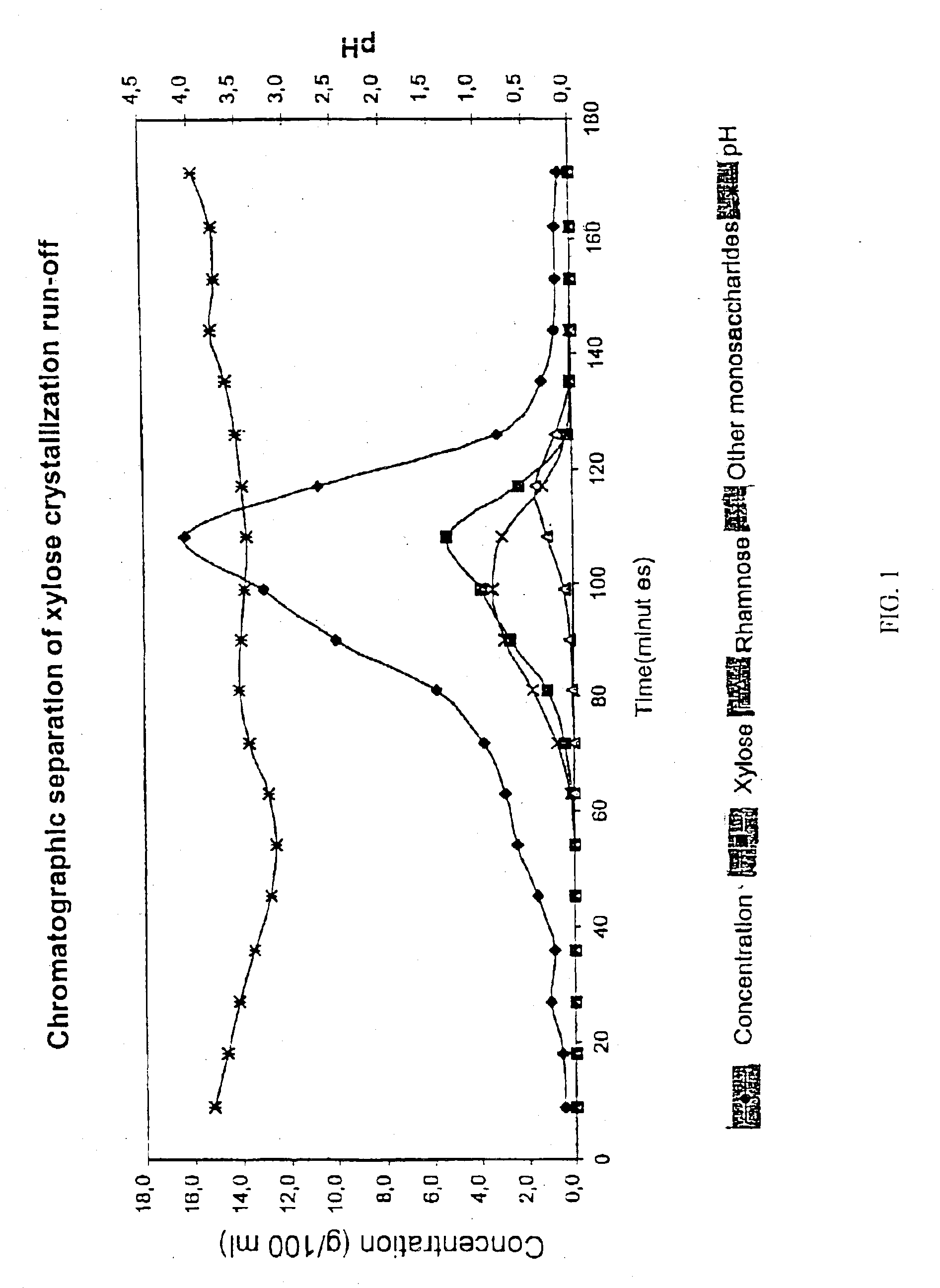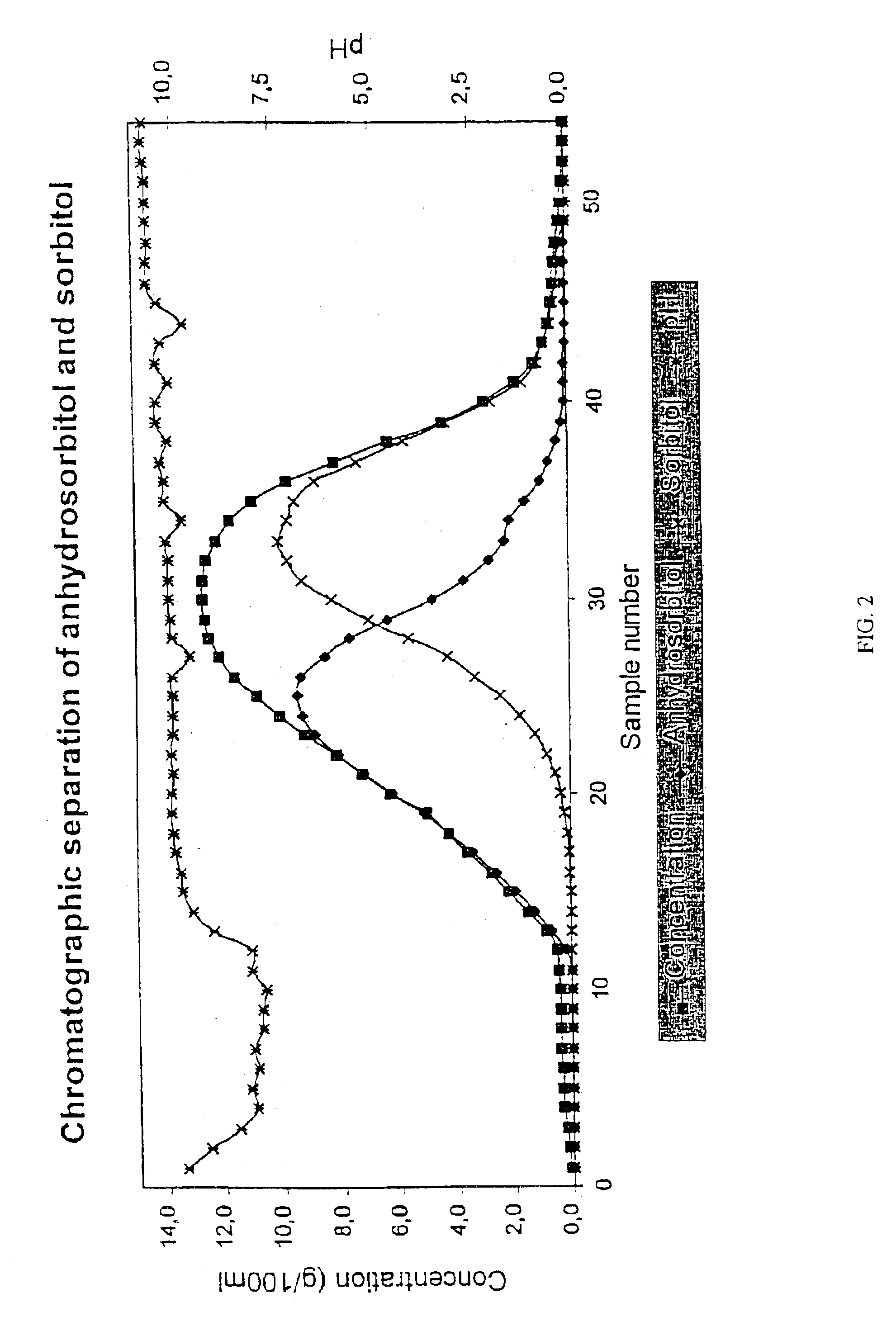Use of a weakly acid cation exchange resin for chromatographic separation of carbohydrates
a cation exchange resin and weakly acidic technology, applied in the direction of cation exchangers, fructose production, sugar derivative preparation, etc., can solve the problems of difficult separation of certain monosaccharides by using strong acidic cation exchange resins, and the method of separating carbohydrates has not been used, and achieves good yield
- Summary
- Abstract
- Description
- Claims
- Application Information
AI Technical Summary
Benefits of technology
Problems solved by technology
Method used
Image
Examples
example 1
Chromatographic Separation of Xylose Crystallization Run-Off with a H+ / Mg2+-Form Resin
[0039]Xylose crystallization run-off, which was beech wood based originally from Mg based si-cooking liquor was subjected to a chromatographic separation. The separation was performed in a laboratory chromatographic separation column as a batch process. The column with a diameter of 0.045 m was filled with an acrylic weakly acid cation exchange resin (Finex™ CA 12 GC) manufactured by Finex Oy, Finland. The resin was an ethyl acrylate-based resin. The height of the resin bed was about 0.70 m. The cross-linkage degree of the resin was 6.0% DVB and the average particle size of the resin was 0.26 mm. The resin was regenerated into mainly H+-form (94%) and partly Mg2+-form (6%) and a feeding device was placed at the top of the resin bed. The temperature of the column and feed solution and eluent water was approximately 65° C. The flow rate in the column was adjusted to 4 ml / min.
[0040]The chromatographic...
example 2
Chromatographic Separation of Anhydrosorbitol (1,4-anhydro-D-glucitol) and Sorbitol with a Na+-Form Resin
[0050]A solution containing anhydrosorbitol (1,4-anhydro-D-glucitol) and sorbitol was subjected to a chromatographic separation. The solution was prepared by dissolving pure anhydrosorbitol and sorbitol into ion-exchanged water. The separation was performed in a laboratory chromatographic separation column as a batch process. The column with a diameter of 0.045 m was filled with an acrylic weakly acid cation exchange resin (Finex™ CA 12 GC) manufactured by Finex Oy, Finland. The resin was an ethyl acrylate-based resin. The height of the resin was about 0.70 m. The cross-linkage degree of the resin was 6% DVB and the average particle size of the resin was 0.26 mm. The resin was in Na+-form. The pH of the resin was high after the manufacturing process. A feeding device was placed at the top of the resin bed. The temperature of the column and feed solution and eluent water was appro...
example 3
Chromatographic Separation of Sucrose, Glucose and Fructose with a Na+-Form Resin
[0061]A solution containing sucrose, glucose and fructose was subjected to a chromatographic separation. The solution was prepared by dissolving pure sucrose, glucose and fructose into ion-exchanged water. The separation was performed in a laboratory chromatographic separation column as a batch process. The column with a diameter of 0.045 m was filled with an acrylic weakly acid cation exchange resin (Finex™ CA 12 GC) manufactured by Finex Oy, Finland. The resin was an ethyl acrylate-based resin. The height of the resin was about 0.70 m. The cross-linkage degree of the resin was 6% DVB and the average particle size of the resin was 0.26 mm. The resin was in Na+-form. The pH of the resin was high after the manufacturing process. A feeding device was placed at the top of the resin bed. The temperature of the column and feed solution and eluent water was approximately 65° C. The flow rate in the column was...
PUM
| Property | Measurement | Unit |
|---|---|---|
| Temperature | aaaaa | aaaaa |
| Temperature | aaaaa | aaaaa |
| Temperature | aaaaa | aaaaa |
Abstract
Description
Claims
Application Information
 Login to View More
Login to View More - R&D
- Intellectual Property
- Life Sciences
- Materials
- Tech Scout
- Unparalleled Data Quality
- Higher Quality Content
- 60% Fewer Hallucinations
Browse by: Latest US Patents, China's latest patents, Technical Efficacy Thesaurus, Application Domain, Technology Topic, Popular Technical Reports.
© 2025 PatSnap. All rights reserved.Legal|Privacy policy|Modern Slavery Act Transparency Statement|Sitemap|About US| Contact US: help@patsnap.com



